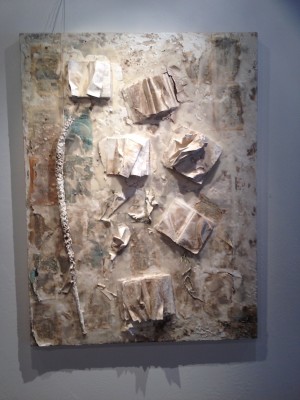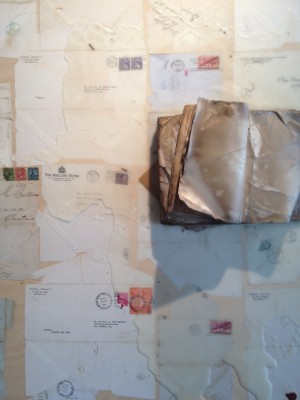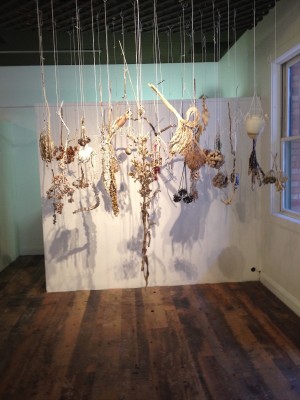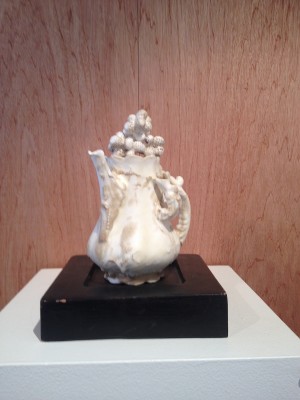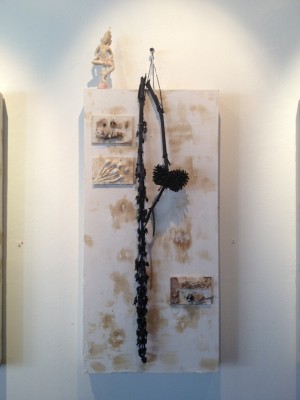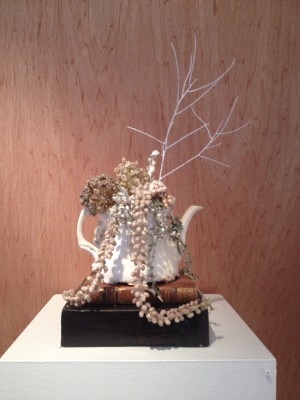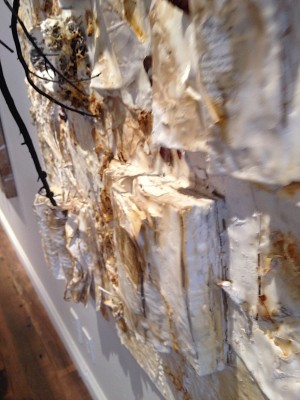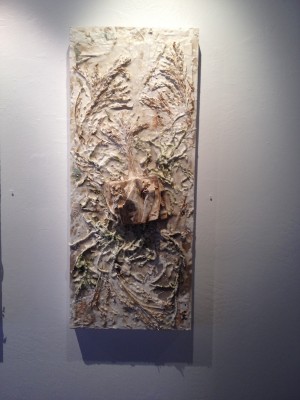
Surface detail, Wetlands, by Jody Guralnick
Jody Guralnick’s Subject to Change: Painted Explorations
The plant materials that attach the surface of Jody Guralnick’s new paintings in Subject to Change: Unnatural Selection (at Wyly Annex, downtown Basalt, through October 11th) are largely gathered by the artist on walks near and around Aspen. A forager and gatherer (when in cities she frequents natural history museums), Guralnick is very precise about including the Latin names of the plants that she culls (e.g., rudbeckia occidentalis, rumex crispus) in her works’ descriptions. (On September 17th a free panel discussion, “The Nature of Nature,” with artists Guralnick, Dick Carter and Linda Girvin, will take place at the Wyly Annex at 174 Midland in Basalt at 5:30 p.m.)
Thoreau in his journal (January 7, 1857) wrote that the value of walking is “equivalent to what others get by churchgoing and prayer. I come home to my solitary woodland walk as the homesick go home. “ If in Guralnick’s recent work there’s a transaction going on between activities of the woodlands and activities of the studio, she also appears to be deliberating between accidental and contrived encounters. An appeal to transcendentalism co-exists alongside the omniscient artist re-purposing meanings by arrangement.
Guralnick washes the surfaces liberally in white porcelain slip. The slip sometimes grabs the plant materials — a purification gesture? Other times such as in the work titled “September, capital creek,” frasera speciosa hangs dyed black in relief from the white ground. Accreting other surfaces further, applications of wax and resin hold books in place; the books’ volumetric materiality avoids any similarity to decoupage.
There’s a lot happening here. Along with the white paramount, one experiences a near-neurasthenia of selection. The plants whorled and held still on this new ground seem strangely provisional; who knows what effects time will wreak on them?
I am struck by how literary the works are, in part because of their whiteness, aka the sublimity of the whiteness of the whale. A more superficial look might locate this pallor as belonging to a decorative Victoriana. It’s sturdier, however, although ambiguity between delicacy and strength offers the work its tension. That Guralnick herself, both a painter and a gifted ceramist with a commercial dish business, gets to celebrate her aptitudes while distinguishing between commercial studio practice, and that of the private artist who dips out for a mind-clearing stroll at “thursday, 4:00,” say, communicates.
What becomes interesting about the painting and sculpture is not only the artist’s freshet of creative activity but that the works effectively compile gatherings. Gatherings in the active sense and then gathering, as it extends one action in time onto a pliable surface where nature and artifice, from “works of fiction,” to “allium,” to “leaves,” remember specific places or experiences. The desire on Guralnick’s part is to use a close classification system for the plants; but the books get called, generically, “works of fiction.” Is “nature” not also perhaps a work of fiction, more and more?
This tactile show in the new pop-up of the Wyly has let Guralnick play with formal concerns that have occupied her art for quite a while now. One can associate between surfaces and gestures and make pictures in your mind: a girl bundling wild hyacinth into her bicycle basket; the quickness of pinning up one’s hair. I loved the kitchen garden of plant specimens. I appreciated the obvious attention to when a work’s additions and subtractions finally make gestalt.
Hence the paintings become descriptive of the “is,” when that present condition is imperceptibly changing so that you are not only looking at still life but into melancholy. The plangent still life is mournful with the presentiment of its own passing.
I began to write this review while in Point Reyes, California, a place I visit every year. This year I started reading Peter Matthiessen’s book Killing Mister Watson. Many descriptions of “plume hunters” scouring Florida swamps of egrets and of crocodiles — rapacious for feathers and skins — scene-set the predations of Mister Watson. I would put the book down and look up to see the same egret that I think I have seen repeatedly, over a decade of staying in the same spot, conduct its delicate ablutions. My pathetic fallacy becomes some kind of inner truth.
Something like this gives credibility to the ecological indicators in Guralnick’s works. They are quiet, but not twee. They capture the stunning, everyday moment that is easy to overlook. In fact maybe they’re partly about that. If selections from places personal to the artist lie in the works’ making, their viewing goes to that imprecise sense of trying to locate oneself, and the sometime inability to do as Thoreau did by walking — “thus dispose of the superfluous.”

